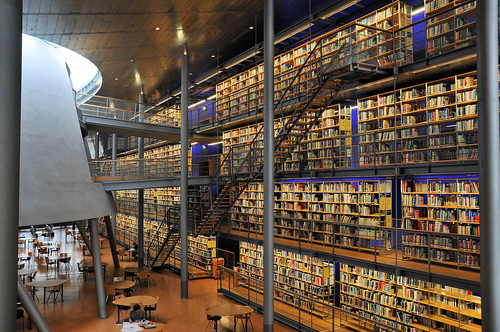Delft University of Technology Library, The Netherlands.

Not all beautiful libraries are old. The Delft University of Technology Library, also called the TU Delft Library, was built in 1997 in Delft, a city in the Netherlands.
It was designed by Francine Houben, an architect who leads a local architecture firm, the Mecanoo bureau. Designing a library is a very difficult task. The TU Libraries offer some interesting books on the subject:
http://koha.library.tu.ac.th/cgi-bin/koha/opac-detail.pl?biblionumber=535123
http://koha.library.tu.ac.th/cgi-bin/koha/opac-detail.pl?biblionumber=579639
http://koha.library.tu.ac.th/cgi-bin/koha/opac-detail.pl?biblionumber=252428
http://koha.library.tu.ac.th/cgi-bin/koha/opac-detail.pl?biblionumber=10757
http://koha.library.tu.ac.th/cgi-bin/koha/opac-detail.pl?biblionumber=139706
http://koha.library.tu.ac.th/cgi-bin/koha/opac-detail.pl?biblionumber=139717
http://koha.library.tu.ac.th/cgi-bin/koha/opac-detail.pl?biblionumber=187992
http://koha.library.tu.ac.th/cgi-bin/koha/opac-detail.pl?biblionumber=108545
http://koha.library.tu.ac.th/cgi-bin/koha/opac-detail.pl?biblionumber=179914

A grassy hill as rooftop.
Since Holland has a famously flat landscape, Houben and her team had the original idea to make a grassy hill out of the roof of the library. This lawn, which is a popular place for students to rest in nice weather, also provides natural insulation for the building. In winter when the hill is covered with snow, students also enjoy skiing and sledding down the roof of the library. The library’s walls are glass, letting in plenty of light. Yet it is unlike many newer libraries which tend to look like airports or hospitals. Delft is well known for cityscapes by the 17th century Dutch painter Johannes Vermeer. It also has a strong scientific tradition, represented by Antonie van Leeuwenhoek (1632–1723), known as the father of microbiology.
The TU Delft Library is worthy of this scientific past. Because of the grass roof, it needs less air conditioning than other buildings of its size. During rainstorms, the grassy roof also absorbs some of the water, preventing rapid flooding. It also acts as soundproofing. There is a cone shape in the center of the roof which allows light to enter the reading room. Skylights bring in further light, direct and reflected. According to the Mecanoo architecture bureau, the cone is a “symbol of technology.” In 2013 Houben gave an interview in which she said that libraries are the “most important public buildings, like cathedrals were many years ago.”
Books and computers.
Houben does not believe that the growth of digitalization will make libraries or books obsolete. She notes that the TU Delft Library is the most popular place in that city, and not just for tourists. So, unlike the rest of the Delft University of Technology, which is mostly concrete, Houben and her team planned a more welcoming and friendly atmosphere. Flowers and trees with lawns are complemented by extended bookshelves, reminding visitors that a library is about books. There are also many computers and up-to-date technology. Part of the Dutch interest in the environment is reflected by the choice not to use traditional air conditioning units, which would interfere with the design and not be as ecologically efficient. Instead, there is a system of cold storage. Sand from 45 to 70 meters below the library is insulated with clay. Two tubes are used to pump water up from and back to the cold storage. In winter the water which is brought up is comparatively warm, and it affects the building’s temperature until the water cools off. Then the water is returned underground. In summer the cooler ground water does the reverse, acting as air conditioning.

The TU Delft Library offers about one thousand study spaces, 300 of them with computer terminals. There are areas for study at different levels, but most books are housed in the building’s basement, where the humidity and temperature are carefully controlled. These must be requested by library users and are delivered by staff. Otherwise around 80,000 books which are the most recent and in-demand are on open access and may be freely consulted by students and faculty with no need to ask staff to find them. Several thousand periodicals are also available on the library’s ground level. The TU Delft Library makes a point of serving the local and international community on technological issues as well as fulfilling the needs of the university community. It also offers the esthetic pleasure of reading and looking at books as well as modern computerized research tools which may be accessed on campus or at a distance. Offices for library staff are located on five levels at the outer edge of the building.
Asian inspiration.
In another interview in 2014, Houben explains that part of her inspiration as an architect comes from Asia, specifically from Japan where she studied for some time:

While she had studied at TU Delft, the architecture professors there taught the kind of cold mechanical modernism which makes so many new library buildings disappointing and hard to love. Instead of this modernist approach, Houten preferred a more humane alternative. She used the occasion of the TU Delft Library to contradict past architectural theory which she disagreed with. Rather than strictly following one theory, she explains: “We enjoy the fun in finding the best solution to a given problem. You could say that we work in layers, where technical, human and playful aspects of architectural practice are unified.” Perhaps because of her focus on fun and playfulness, the TU Delft Library is indeed an enjoyable and celebratory place to spend time in. Above all, Houten values “optimism and freedom” as a “source of energy and stamina.” Perhaps Thai architects will one day learn something from this gifted Dutch architect.

(all images courtesy of TU Library Delft and Wikimedia Commons).
